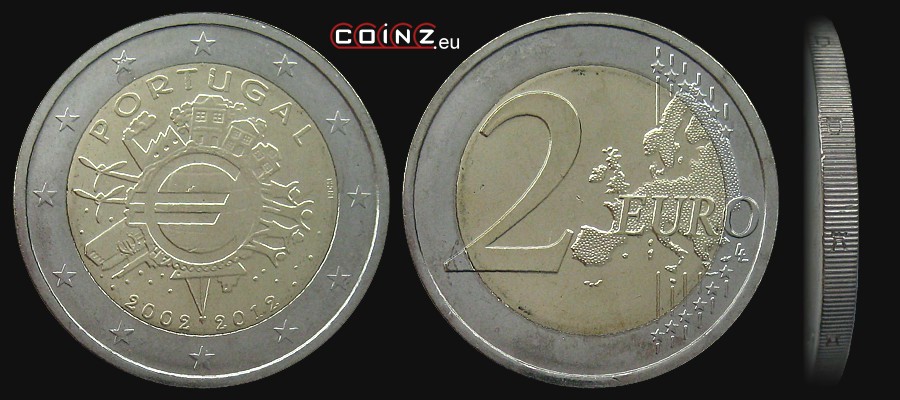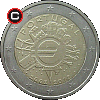2 euro PORTUGAL (2012) 10 Years of Euro in Circulation


| diameter: | weight: | thickness: | alloy: |
| 25.75 mm | 8.5 g | 2.22 mm | Cu75Ni25/Cu75Zn20Ni5 |
obverse:
in the centre a concave symbol of the euro currency € inscribed into a globe; around the globe several simplified pictographs symbolising society and industry; along the top edge: PORTUGAL; along the bottom edge dates: 2002 2012; at the edge a ring of twelve five-pointed stars - symbol of the European Union
reverse:
edge:
reeded with concave seven castles and five shields from Portuguese Coat of Arms:


issue date:
24 II 2012
withdrawal date:
circulating
designer:
Helmut Andexlinger (concave initials A.H. on the globe surface above the date 2002 on the obverse), Luc Luycx (initials LL below letter 'O' in EURO on the reverse)
mint:
Imprensa Nacional - Casa da Moeda (National Press - The Mint), Lisbon (mint mark INCM at the right edge of the obverse)
mintage:
| 2012 | 500 000 | + 10 000 in boxed sets |
interesting facts:
On January 1st, 1999 euro [EUR] became an official (although virtual) currency in 11 countries of the European Union. The first coins were minted already in 1999, but real money entered circulation only on January 1, 2002. In the competition for an obverse design commemorating this fact, the proposal of Helmut Andexlinger from Austrian Mint has won. All of the euro-zone countries issued coins with the same obverse motif. Let's meet defeated finalists of the voting for the best commemorative design.


last update: 27 I 2013
coins catalogue :: katalog monet :: münzkatalog :: catalogue de monnaies :: catálogo de monedas :: catalogo monete :: каталог монет :: κέρματα κατάλογος :: COINZ.eu
© 2010-2025 :: Adam Kubicki :: COINZ.eu :: All rights reserved.


